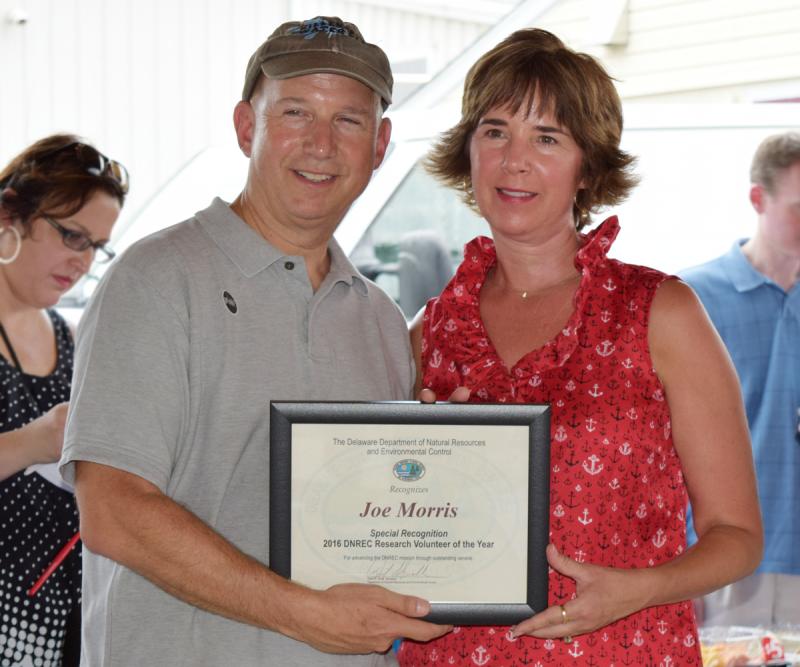Joe Morris posthumously given Outstanding Volunteer Award
On July 28, Amanda Morris accepted the DNREC Outstanding Volunteer Award for her late husband Joe Morris. The ceremony took place at the Delaware State Fair in Harrington, and Gov. Jack Markell was the presenter.
Joe took the time to remove various parts from the fish he cleaned to help different scientists at DNREC’s Fish and Wildlife Section in their studies. He had the equipment to keep the samples cold so they were in good shape for the work. I have no firm count of how many samples Joe collected, but I suspect they numbered in the thousands.
I am sure Joe didn’t do all this work with the expectation of receiving an award. He did it because he knew how important it was for the people who regulate our fisheries to have as much knowledge as possible about the fish they regulate. The studies he helped with will be used by scientists and fishery managers for many years in the future, providing a living legacy for the man who provided the samples upon which the study depended.
Fishing report
Flounder keep coming from the Lewes-Rehoboth Canal on a regular basis. Live minnows seem to be the top bait with jigs tipped with Gulp! a close second. In addition to the flounder, small spot and croaker have been caught from the canal on bloodworms.
Slot rockfish continue to be caught between the bridges in Lewes. This is an early or late-day fishery with live eels and swim shads the top producers. We also had reports of slot rock taken from the Broadkill River on surface lures cast toward the shoreline early or late in the day.
The fishing pier at Cape Henlopen State Park has seen small croaker and spot caught on bloodworms. At times the bite is fast and furious, while at other times it is dead as a mackerel. Then again, that’s pretty much fishing anywhere you go. Flounder catches are made by anglers who fish with jigs or live minnows close to the pilings. Kayakers find flounder alongside the pilings past the end of the pier.
In the bay, a few flounder were caught at the reef sites by those who jig with Gulp! or squid strips directly over the hard structure. Croaker, kings and small trout are also around the reef sites, the Outer Wall and the Coral Beds. A few of the trout are well above the 13-inch minimum size.
Togging at the Outer Wall and Ice Breakers has been slow, but a few big sheepshead have been caught on sand fleas. I suspect the Wall and Ice Breakers also hold spadefish. A very small piece of fresh clam suspended under a bobber and allowed to drift close to the rocks will bring out the spades. Light chumming with clam is a good idea.
The surf is producing good quantities of kingfish. The kings are holding just beyond the breakers, so a long cast is not required. Bloodworms are the best bait, and fishing early or late in the day is always a good idea in the summer.
Indian River Inlet saw much-improved flounder fishing with the best bite from the campground or the Coast Guard Station on back to Indian River Bay. As a general rule, incoming water is the best time to fish in the summer. When boat traffic becomes a problem, try the slough alongside Burton’s Island or the deep hole close to the Red Can at the mouth of the inlet.
Small croaker and spot are in the back bays and will take bloodworms. You might try using a live spot for flounder bait.
There was improvement in the flounder fishing at the Old Grounds. Jigging with a bucktail or leadhead tipped with Gulp! or squid strips has been the secret to success. The hot summer sun has heated the water, and the flounder have moved to the deeper areas. I would suggest trying water in the 80- to 100-foot depths. Of course, drift conditions will dictate just how deep you can fish without using so much weight it feels like you are dragging the anchor from an aircraft carrier.
The red-hot tuna bite at Massey’s Canyon slowed over the weekend. A few gaffer dolphin were taken on butterfish chunks or by trolling along the edge of the underwater structure.
The canyons turned on just in time for the White Marlin Open next week. Numerous flags were flying from outriggers as the boats returned from the Baltimore and Washington canyons. Both white and blue marlin have been caught along with gaffer dolphin and bigeye tuna. I expect the chumming bite for yellowfin tuna to turn on in the Washington as it has done for the past few years.

























































